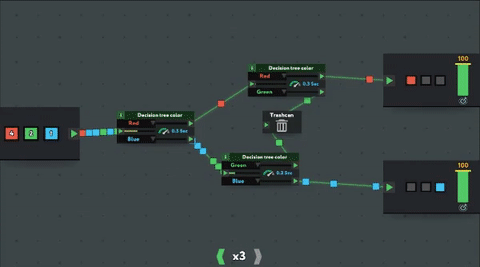After you find a font that you would like to use with an Office application, you can download it and install it through the operating system that you are currently using on your computer. Because fonts work with the operating system, they are not downloaded to Office directly. Concept art playbook. Ctrl+Paint Store. About / Contact Resources FAQ. Digital Painting, Simplified. This is a collection of short, free, videos on the basics of digital painting. Hundreds of them. Did you learn something? Tell a friend about the site. Want to learn more?
- While True: Learn() Art Pack Download 1.14
- While True: Learn() Art Pack Download Free
- While True: Learn() Art Pack Download Torrent
In December 2015, a photograph of a wolf pack marching through the snow began circulating via Facebook along with an inaccurate description about its hierarchy:
“A wolf pack: the first 3 are the old or sick, they give the pace to the entire pack. If it was the other way round, they would be left behind, losing contact with the pack. In case of an ambush they would be sacrificed. Then come 5 strong ones, the front line. In the center are the rest of the pack members, then the 5 strongest following. Last is alone, the alpha. He controls everything from the rear. In that position he can see everything, decide the direction. He sees all of the pack. The pack moves according to the elders pace and help each other, watch each other.”
While True: Learn() Art Pack Download 1.14


Despite the image’s popularity, however, the attached description of the inner workings of a wolf pack are inaccurate.
The photograph shown was taken by Chadden Hunter and featured in the BBC documentaryFrozen Planet in 2011, with its original description explaining that the “alpha female” led the pack and that the rest of the wolves followed in her tracks in order to save energy:
A massive pack of 25 timberwolves hunting bison on the Arctic circle in northern Canada. In mid-winter in Wood Buffalo National Park temperatures hover around -40°C. The wolf pack, led by the alpha female, travel single-file through the deep snow to save energy. The size of the pack is a sign of how rich their prey base is during winter when the bison are more restricted by poor feeding and deep snow. The wolf packs in this National Park are the only wolves in the world that specialize in hunting bison ten times their size. They have grown to be the largest and most powerful wolves on earth.
While this description is more accurate than the one shared in the viral Facebook post, some researchers would nonetheless dispute the use of the term “alpha.” In David Mech’s 1999 paper “Alpha Status, Dominance, and Division of Labor in Wolf Packs,” he argued that the concept of an “alpha” wolf who asserts his or her dominance over other pack members doesn’t actually exist in the wild:
While True: Learn() Art Pack Download Free
Labeling a high-ranking wolf alpha emphasizes its rank in a dominance hierarchy. However, in natural wolf packs, the alpha male or female are merely the breeding animals, the parents of the pack, and dominance contests with other wolves are rare, if they exist at all. During my 13 summers observing the Ellesmere Island pack, I saw none.
Thus, calling a wolf an alpha is usually no more appropriate than referring to a human parent or a doe deer as an alpha. Any parent is dominant to its young offspring, so “alpha” adds no information. Why not refer to an alpha female as the female parent, the breeding female, the matriarch, or simply the mother? Such a designation emphasizes not the animal’s dominant status, which is trivial information, but its role as pack progenitor, which is critical information.
This photograph is “real” in the sense that it shows a pack of wolves in Wood Buffalo National Park, but the pack is not being led by the three oldest members and trailed by an “alpha” wolf, as implied by a viral Facebook post. Instead, one of the stronger animals leads the group in order to create a path through the snow for them.
While True: Learn() Art Pack Download Torrent
Learning the Tarot - An On-line Course
Welcome to Learning the Tarot - my course on how to read the tarot cards. The tarot is a deck of 78 picture cards that has been used for centuries to reveal hidden truths. In the past few years, interest in the tarot has grown tremendously. More and more people are seeking ways to blend inner and outer realities so they can live their lives more creatively. They have discovered in the tarot a powerful tool for personal growth and insight.How Does This Course Work?
My main purpose in this course is to show you how to use the cards for yourself. The tarot can help you understand yourself better and teach you how to tap your inner resources more confidently. You do not have to have 'psychic powers' to use the tarot successfully. All you need is the willingness to honor and develop your natural intuition.Learning the Tarot is a self-paced series of 19 lessons that begin with the basics and then move gradually into more detailed aspects of the tarot. These lessons are geared toward beginners, but experienced tarot users will find some useful ideas and techniques as well. For each lesson there are some exercises that reinforce the ideas presented. The Cards section contains information about each of the tarot cards. You can refer to this section as you go through the lessons and later as you continue your practice. These are the main features of the course, but there are many other pages to explore here as well.
What is the History of this Course?
I began writing this course in 1989. I had been studying the tarot for some years, and I found that I was developing some ideas about the cards and how they could be used as a tool for inner guidance. In October 1995, I created this website. In October 1998, Learning the Tarot was published as a paperback.My experience with the cards is in doing readings for myself, friends, relatives and acquaintances...probably the kind of tarot you are interested in. The tarot cards are not difficult to learn, but there is always more to them that can be learned. They are deceptively simple, but surprisingly rich.

What Is Needed For the Course?
The only real requirement for this course is a tarot deck. If you don't have a deck, read through my comments on buying your first deck and then browse through my Tarot Deck Section. There are many choices. The on-line version of Learning the Tarot is illustrated with the popular Rider-Waite deck. This is a good deck to start with because there are pictures on every card which helps when you are learning. If you already have a different 78 card deck, you may use it with the course. The principles of tarot work are much the same no matter what deck you use. You can buy tarot decks in many places now. Bookstores often carry them, and many internet sites offer a variety of tarot decks for sale.How Can I Take This Course?
Internet: You can use this course while connected to the Internet, just as you are now. The course is free, but please read the copyright message first. When you're ready, go to the contents page and begin exploring!
At Home: You can purchase Learning the Tarot or The Big Book of Tarot from a local or on-line bookstore.
I hope you're intrigued enough to try this course. If you're still not sure, read Lesson 1. I think you will find Learning the Tarot interesting at least, and perhaps the tool you have been looking for to develop your unrealized potential.